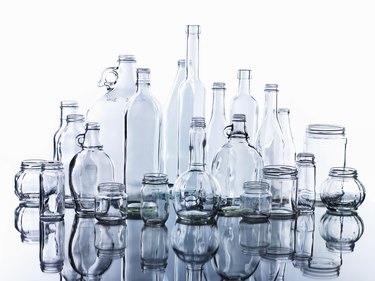
Preparation is key when it comes to spray painting glass; even a brand-new glass item requires a bit of prep work for the paint to adhere properly. Any general-purpose spray paint adheres to glass, but it may chip or scratch over time if the painted item is handled frequently.
The Wonders of Washing
Video of the Day
Washing the glass is a must before painting, even if the glass looks completely clean, such as a brand-new mason jar fresh out of the box. Wash submersible glass items such as jars, bottles or plates in warm water with a small amount of dish soap, using a dishcloth or sponge to wipe down all surfaces. Wash the entire glass, even areas you don't plan to paint, to remove dust and debris. If the glass item cannot be soaked in water, such as a mirror, wipe down the glass surfaces with a damp microfiber cloth or sponge; then dry it thoroughly.
Video of the Day
Label and Residue Removal
If that perfect project piece has a label or sticker on it, loosen it by soaking the glass in the soapy dish water for a while. Rub the papery portion of the label or sticker off with your fingers or a nylon scrub pad, depositing the debris in the trash. Scrub as much adhesive residue as possible. If you cannot get some of the glue-like material off the glass, use a citrus sticker-removing solution. Rinse the glass; then wash and dry it completely. For non-submersible items, apply a wet paper towel or sponge directly over the sticker or label and allow it to sit for several hours, checking frequently to ensure that water doesn't drip into areas such as the space between a frame and mirror. Rub the residue away with your fingers and a citrus-based sticker remover; then wash the glass areas with a damp microfiber cloth.
Squeaky Clean Solution
Some glass feels as though it has a bit of a film on it; even if yours doesn't, wipe it down with rubbing alcohol to make it even more receptive to spray paint. The alcohol removes greasy film, soap residue and fingerprints that may hinder the painting process otherwise. Use a soft cloth to apply the alcohol and allow the glass to dry completely before painting.
Perfection With Spray Paints
Set up a project space in a well-ventilated area -- outdoors, if possible, on a non-windy day. Cover the work area with newspaper or use a cardboard box as a makeshift spray booth. After shaking the spray can for a minute or two, spray the glass by starting each paint stream slightly before the object, ending slightly beyond it, keeping the spray can 12 to 18 inches from the project. While it may be tempting to apply one heavy coating instead of several thin layers, thin coats adhere better and help avoid drips and paint blobs. If painting a jar, bowl, bottle or other glass vessel, place the item upside-down on the project surface to paint it so the paint thoroughly covers the bottom visible edge of the object once the paint dries. If you plan to use the glassware for food or drinks, keep the paint away from the lip of the glass and out of all areas that will come into contact with food or beverages. Wash the item only with gentle cloths or sponges; scrub pads or the dishwasher may remove the paint.